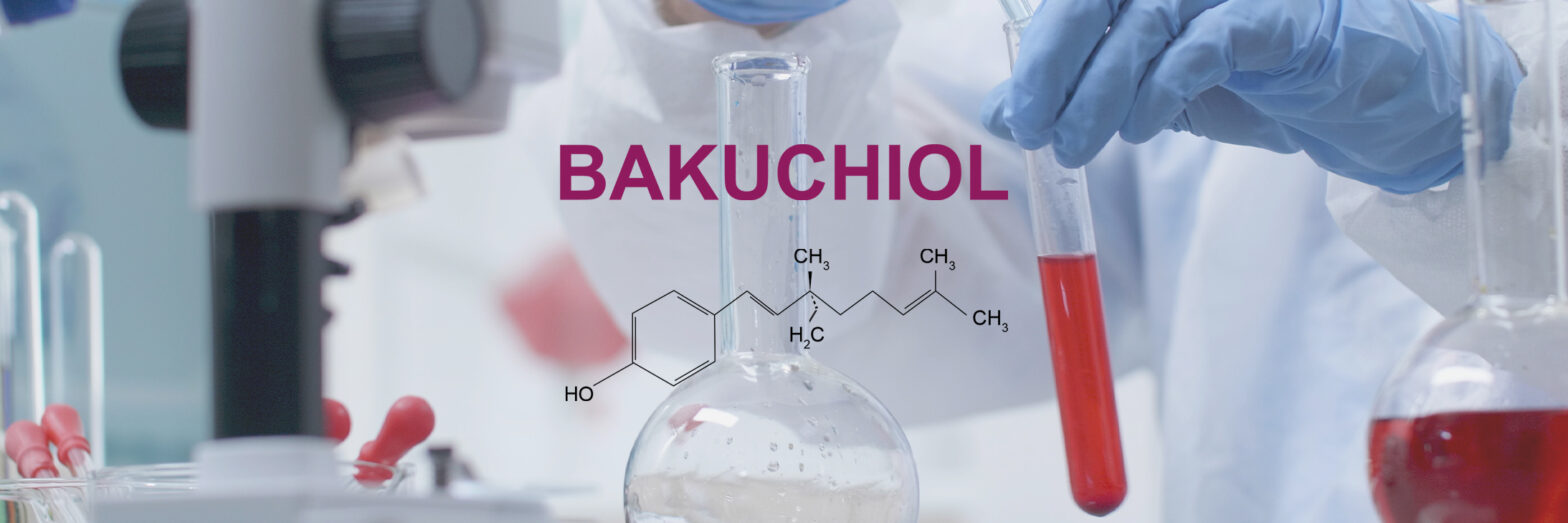INTRODUCTION
Bakuchiol is a meroterpene in the class terpenophenol. It is a natural, vegan plant-derived alternative to retinol, which is vitamin A based element that supports skin cell turnover and collagen production for more supple and radiant skin. Bakuchiol has very similar traits, but it is gentle on the skin without any drawbacks like redness and irritation.
Manufacture
It is isolated from Psoralea corylifolia seed and was called Bakuchiol based on the Sanskrit name of the plant, Bakuchi.
| Synonyms | 4-(3-Ethenyl-3,7-dimethyl-1,6-octadienyl)-phenol |
| CAS no. | 10309-37-2 |
| EINECS no. | 685-515-4 |
| Molecular formula | C18H24O |
| Molecular weight | 256.38 |
| Structure |
APPLICATIONS
Bakuchiol is known for its Antibacterial, Antioxidant, Anti-inflammatory and Antiaging activity on skin. It can be used in skin care products like serums, creams, lotions, cleansers.
| Evens skin tone | Bakuchiol deeply penetrates the skin to help lessen the appearance of dark spots or areas of hyperpigmentation. |
| Reduces the appearance of fine lines | Like retinol, bakuchiol tells your cells to regenerate and make collagen, “plumping” your skin and reducing the look of lines and wrinkles. |
| Doesn’t cause dryness or irritation | While retinol and other skincare ingredients may dry out skin or cause irritation, bakuchiol is more gentle and isn’t known to cause any irritation. |
| Speeds up skin cell regeneration | Bakuchiol sends signals to your cells that it’s time to amp up collagen production and cell turnover. |
| Suitable for all skin types | Being gentle on skin, most anyone can use bakuchiol. |
| Helps soothe and heal skin | By promoting cell turnover and healthy cell regeneration, Bakuchiol may help soothe and heal your skin from the inside out. |
SPECIFICATIONS
| Test | Unit | Specification |
|---|---|---|
| Appearance | – | Viscous liquid |
| Color | – | Yellow to light brown |
| Odor | – | Conform to standard |
| Identification IR | – | Conform to standard |
| Water content | % | NMT 1.0 |
| Sulfated ashes | % | NMT 0.1 |
| HPLC Purity | % | Min 99.0 |
| Impurities: • Psorelin (HPLC) • Isopsorelin (HPLC) | % % | NMT 0.01 NMT 0.01 |
| Microbial count: • Total aerobic bacteria plate count • Mold and Yeast count • Pathogens by Enrichment method | cfu/g cfu/g cfu/g | NMT 100 NMT 100 Absent in 1 gm |
PACKING
Export worthy.
STORAGE
Store in original container, protected from light and heat.
REACH Status
Not applicable.
No matter the quantity you need, our exceptional quality and service will make ExSyn your supplier of choice! If you need any additional information or SDS, please contact us.
5-Methyl-3-vinyl-2-oxazolidinone (V-MOX) is a highly reactive monomer valued for its low viscosity, mild odor, and excellent reactivity. It is widely used as a reactive diluent in UV-curable inks and coatings, where it enhances adhesion, produces brighter colors, and improves safety compared to conventional diluents. In addition, V-MOX serves as a key building block in the synthesis of kinetic hydrate inhibitor (KHI) polymers, which are applied in oil and gas production to prevent hydrate blockages in pipelines.
Zinc ricinoleate is the zinc salt of ricinoleic acid, a hydroxylated fatty acid derived mainly from castor oil (Ricinus communis). It appears as a white to slightly yellowish powder, waxy solid, or paste, depending on formulation. Its most valuable property is its ability to trap and absorb odor molecules such as amines, sulfides, and short-chain fatty acids, making it an essential ingredient in deodorant and odor-control products.
2-(tert-Butyl amino)ethyl methacrylate (TBAEMA) is a functional methacrylate monomer that contains a secondary amine group and a hydrophobic tert-butyl moiety, giving it excellent versatility in pH-responsive and adhesion-enhancing polymer systems.
It is valued in printing ink formulations for its ability to enhance adhesion, flexibility, and surface interaction.
Commonly known as potassium bis(fluorosulfonyl)imide (KFSI), the compound has a three-carbon backbone bearing six fluorine atoms and two sulfonimide (-SO₂F) groups. The molecule’s architecture lends it both high chemical stability and useful reactivity. Because of its excellent ionic conductivity and thermal / electrochemical stability, it finds use in advanced electrolyte formulations—for example in lithium-ion and next-generation batteries, in ionic liquids, and in other electrochemical systems.
Colchicine is a naturally occurring alkaloid obtained primarily from the autumn crocus (Colchicum autumnale) and related species. It has been used in medicine for centuries, especially for the treatment of gout and Familial Mediterranean Fever. In modern medicine, Colchicine is valued also in conditions like pericarditis, Behçet’s disease, and certain dermatological and cardiac disorders.
1-Butylimidazole is a versatile organic heterocyclic compound belonging to the imidazole family, where a butyl group (–CH₂–CH₂–CH₂–CH₃) is attached to the nitrogen atom at the 1-position of the imidazole ring. Its applications span organic synthesis, materials science, and bioactive compound development due to its tunable physicochemical properties and structural versatility.
Atropine sulfate monohydrate is a chemical compound, specifically a salt of atropine and sulfuric acid, with one water molecule (monohydrate) attached. It is commonly used as a medication and in research due to its anticholinergic properties, meaning it blocks the effects of acetylcholine at muscarinic receptors.
4-Aminobenzoic acid, commonly abbreviated as PABA, is an aromatic amine and carboxylic acid compound. It consists of a benzene ring substituted with an amino group (–NH₂) in the para position to a carboxylic acid group (–COOH).
2-Amino-5-Nitrophenol (5-NAP) is an organic compound with the molecular formula C₆H₆N₂O₃. It is a substituted phenol with both an amino group (-NH₂) and a nitro group (-NO₂) attached to a benzene ring, along with a hydroxyl group (-OH).
